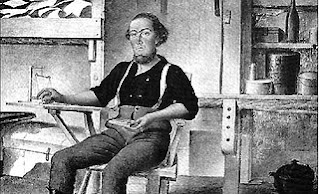Great Warriors II
 In 2016, I began a blog on the tribes, warriors and leaders of America's eastern frontier beginning from the explorations of Hernando de Soto (1539-1541), French exploration beginning with Samuel de Champlain (1600), the English landings at Jamestown (1607) and Plymouth Rock (1620), and other European explorations and settlement through the Beaver Wars of the 17th century, the colonial wars of the 18th century including the Seven Years/French and Indian War (1755-1763). to the Revolutionary War (1775-1783) and on to the period of Indian Removal (1830). The blog covered the Eastern Woodlands tribes, both northern and southern, such as the Iroquoian peoples (Mohawk, Seneca and Cherokee), Algonquian speakers such as the Shawnee, Lenape, etc. Famous warriors such as Guyasuta of the Seneca, Ousamequin Massassoit of the Wampanoag, Joseph Brant of the Mohawk, Dragging Canoe of the Chickamauga Cherokee, and others.
In 2016, I began a blog on the tribes, warriors and leaders of America's eastern frontier beginning from the explorations of Hernando de Soto (1539-1541), French exploration beginning with Samuel de Champlain (1600), the English landings at Jamestown (1607) and Plymouth Rock (1620), and other European explorations and settlement through the Beaver Wars of the 17th century, the colonial wars of the 18th century including the Seven Years/French and Indian War (1755-1763). to the Revolutionary War (1775-1783) and on to the period of Indian Removal (1830). The blog covered the Eastern Woodlands tribes, both northern and southern, such as the Iroquoian peoples (Mohawk, Seneca and Cherokee), Algonquian speakers such as the Shawnee, Lenape, etc. Famous warriors such as Guyasuta of the Seneca, Ousamequin Massassoit of the Wampanoag, Joseph Brant of the Mohawk, Dragging Canoe of the Chickamauga Cherokee, and others.  However, by the time the Five Southeastern Tribes and other tribes east of the Mississippi were forcibly removed from their land, tribes west of the Mississippi had already experienced European incursion in the form of disease and displacement by other tribes pushing west to get beyond the reach of Settlers. While European contact such as trade with the Spanish brought benefits like the horse and firearms, the costs to these people in terms of disease, social displacement and White interference in ancient tribal rivalries caused diminished populations and other hardships. Inevitably, as Settlers pushed beyond the Mississippi, they were bound to collide with Natives determined to protect their home and hunting ranges. Gold rushes, such as those in Colorado and later South Dakota, further exacerbated the problem. In the east, beaver pelts were a hot trading item. In the west, it was the buffalo. Buffalo skins provided warm clothing against harsh western winters. Too often, hunters slaughtered buffalo, took the hide and left the flesh, spoiling foodstuffs that would have kept a Native family alive during the winter.
However, by the time the Five Southeastern Tribes and other tribes east of the Mississippi were forcibly removed from their land, tribes west of the Mississippi had already experienced European incursion in the form of disease and displacement by other tribes pushing west to get beyond the reach of Settlers. While European contact such as trade with the Spanish brought benefits like the horse and firearms, the costs to these people in terms of disease, social displacement and White interference in ancient tribal rivalries caused diminished populations and other hardships. Inevitably, as Settlers pushed beyond the Mississippi, they were bound to collide with Natives determined to protect their home and hunting ranges. Gold rushes, such as those in Colorado and later South Dakota, further exacerbated the problem. In the east, beaver pelts were a hot trading item. In the west, it was the buffalo. Buffalo skins provided warm clothing against harsh western winters. Too often, hunters slaughtered buffalo, took the hide and left the flesh, spoiling foodstuffs that would have kept a Native family alive during the winter.Native leaders rose to advocate for their people, and sometimes to lead them in war against the Whites. Crazy Horse of the Oglala Sioux, Sitting Bull of the Hunkpapa Sioux, Ouray of the Uncompahgre Ute, Joseph of the Nez Perce, and Cochise, Geronimo and Victorio of the Apache. As had their counterparts in the east, their struggles were doomed as more and more Settlers poured into their territories, back by the U.S. Army. Leaders faced the conundrum of war or trying to make peace and spare their people as much suffering as possible. Crowded onto reservations, unable to hunt or provide for themselves, forbidden to practice their own culture, Natives often chose to rebel rather than suffer these injustices. From the Comanche wars in Texas in 1820 to the final Ute Wars of the early 20th century, leaders and warriors, men and women, led their people in this delicate and often disastrous spiral. This is that story.




Comments
Post a Comment